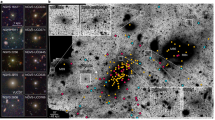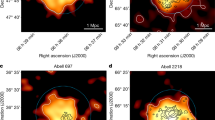Abstract
SINCE 1966 (ref. 1) there has been observational evidence2–4 that quasi-stellar radio sources (QSRs) and compact radio galaxies are ejected from galaxies. Whatever distance scale one uses, one of the characteristics of QSRs and compact radio galaxies is that a great deal of energy is compressed into very small dimensions. Unless very special conditions prevail, such concentrated sources would be expected to expand with time. Indeed, the short lifetimes which are inferred from their rapid rate of energy expenditure, the associated jets of material and the prevalence of ejected radio pairs across the sources all attest to expansion and eruption.
This is a preview of subscription content, access via your institution
Access options
Subscribe to this journal
Receive 51 print issues and online access
$199.00 per year
only $3.90 per issue
Buy this article
- Purchase on Springer Link
- Instant access to full article PDF
Prices may be subject to local taxes which are calculated during checkout
Similar content being viewed by others
References
Arp, H., Science, 151, 1214 (1966).
Arp, H., Astrophys. J., 148, 321 (1967).
Arp, H., Astrophyzika, 4, 59 (1968).
Arp, H., Astron. J. (in the press).
Arp, H., Astron. Astrophys. (in the press).
de Vaucouleurs, G., and de Vaucouleurs, A., Reference Catalogue of Bright Galaxies (Univ. Texas Press, Austin, 1964).
Holmberg, E., Astron. J., 66, 120 (1961); Uppsala Astr. Obs. Medd. No. 138.
Humason, M. L., Mayall, N. U., and Sandage, A. R., Astron. J., 61, 97 (1956).
Sargent, W. L. W., Astrophys. Lett., 153, 135 (1968).
Arp, H., Pub. Astron. Soc. Pacific, 80, 129 (1968).
Sersic, J. L., Astron. Soc. Pacific Leaflet No. 453 (1967); Astrophyzika, 4, 105 (1968).
de Vaucouleurs, G., Stars and Stellar Systems (edit. by Kuiper, G., and Middlehurst, B.), 9 (1969).
De Vaucouleurs, G., and de Vaucouleurs, A., Astron. J., 68, 96 (1963).
Vorontsov-Velyaminov, B., Astron. Soc. Pacific Leaflet No. 458 (1969).
Author information
Authors and Affiliations
Rights and permissions
About this article
Cite this article
ARP, H. Redshifts of Companion Galaxies. Nature 225, 1033–1035 (1970). https://doi.org/10.1038/2251033b0
Received:
Issue Date:
DOI: https://doi.org/10.1038/2251033b0
This article is cited by
-
Galaxy clusters as relativistic spherically-symmetrical inhomogeneities
Astrophysics and Space Science (1977)
-
Quasars and the cosmological distance scale
Nature (1976)
-
Variable G: a solution to the missing mass problem
Nature (1976)
-
Two luminosity classes of quasars
Astrophysics and Space Science (1975)
Comments
By submitting a comment you agree to abide by our Terms and Community Guidelines. If you find something abusive or that does not comply with our terms or guidelines please flag it as inappropriate.



